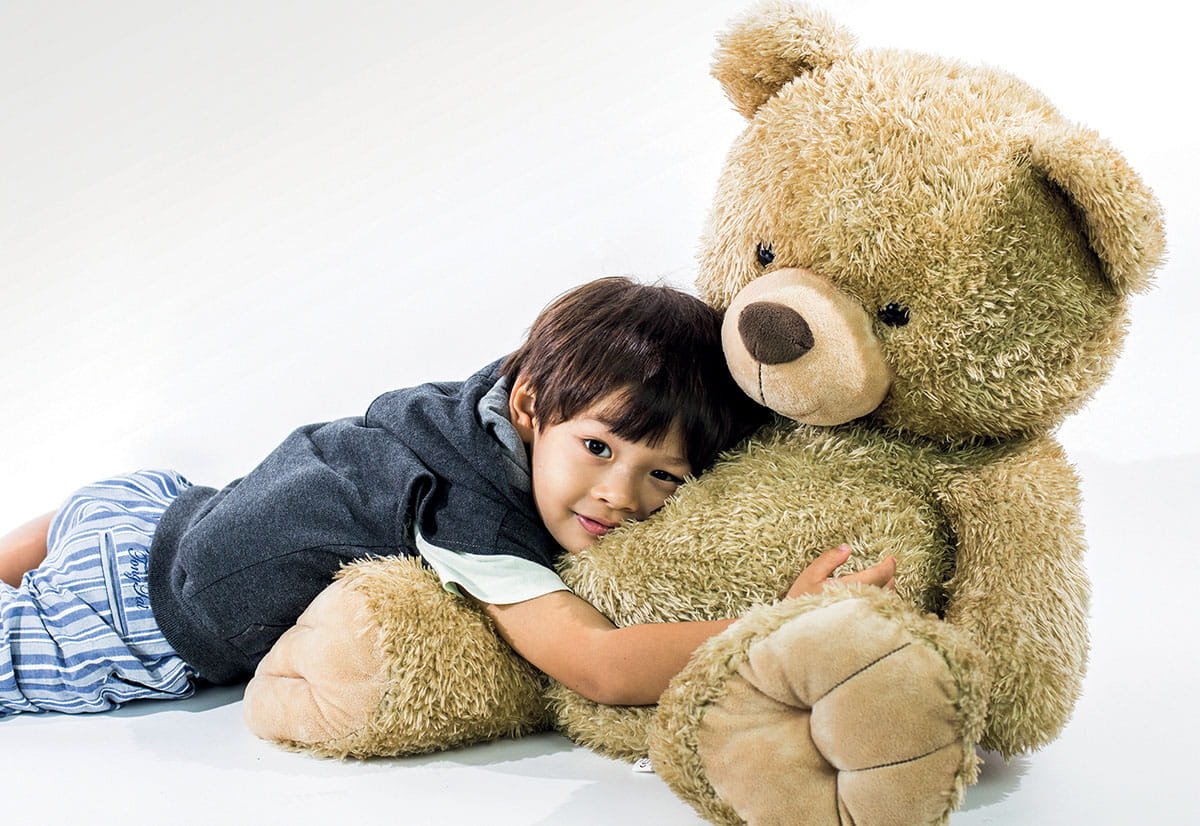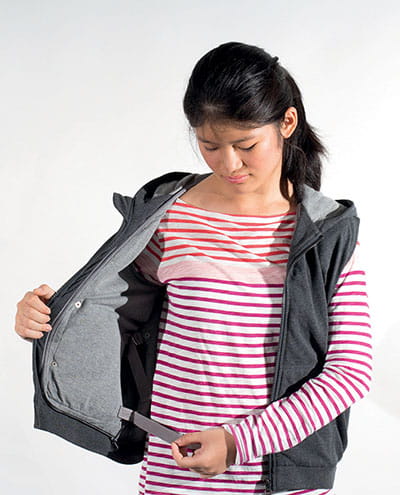Stories > Magic Touch
Magic Touch
Tjacket, produced by a Singapore start-up, is changing lives for its ability to reassure and calm people suffering from sensory processing disorders, anxiety disorders, hyper-arousal and chronic stress.

The Tjacket is embedded with airbag modules, which can be remotely controlled via Bluetooth or through an iOS or Android app.
BY SASHA GONZALES
PHOTOGRAPHY PHOTOS TWARE
t is a nondescript hooded vest, but when Willow May from the United Kingdom puts the Tjacket on, she says it feels like being given a huge cuddle. “I feel calmer and less anxious,” says May, an adult with autism.
“When I have meltdowns or get overexcited, it reassures me and makes me feel incredibly safe and secure. Using it just before bedtime on the pre-set programmes helps me calm down after an overwhelming day.” The Tjacket is produced by Singapore start-up Tware, which was co-founded by James Teh, Lin Wei Liang and Lai Sep Riang. The “T” in Tjacket stands for touch. It is a wearable touch technology vest that simulates the feeling of a hug. Lin and Lai now jointly manage Tware after Teh left the company around a year ago.
The jacket provides deep-pressure therapy in the form of a continuous firm pressure on the surface of the body. It is used to calm, decrease stimulation and increase attentiveness of the individual. Deeppressure therapy has been widely used by occupational therapists to help with sensory processing issues, anxiety disorders, hyperarousal, restlessness and chronic stress. These are common characteristics in individuals with autism spectrum disorders (ASD), attention-deficit hyperactive disorder (ADHD) and sensory processing disorders.
According to the Centers for Disease Control and Prevention, the national public health institute of the United States, around 1 per cent of the world population has ASD.
With the Tjacket, Lin and Lai hope to bring comfort to the lives of those with ASD and other types of disorders, and enable them to have greater control over their symptoms.
As a post-graduate student at the National University of Singapore (NUS), Teh had developed the technology for a remote hugging jacket at the Keio-NUS Cute (Connective Ubiquitous Technology for Embodiments) Center research lab in 2011 as part of his PhD project on wearable technology. The Keio-NUS Cute Center is a joint collaboration between NUS and Japan’s Keio University, with the aim of facilitating partnerships in research on interactive digital media.
“ As soon as I put the jacket on one of my clients, he smiled instantly. It works better than a weighted vest because the children or parent can regulate the strength of the ʻhugʼ, and it doesnʼt feel as heavy to wear. Also, it is inconspicuous, so kids donʼt feel embarrassed wearing it. ”
Karina D Bartley, a special needs educator in Australia
Teh had initially conceived the jacket for parents who were away from their kids so they could deliver hugs remotely. An occupational therapist he met gave him the idea that it could also be used to help those with ASD and other sensory disorders. To find out how it can improve lives, Teh sought the help of one of his students, Lai, and in 2011, the pair teamed up with Lin, who was studying at Keio University in Japan at the time. Says Lin, Tjacket co-founder and chief innovation officer: “I was interested in being part of a start-up, so when my Japanese professor, who was involved with the Keio-NUS Cute Center told me what James was doing, I called to ask how I could help. After graduating, I returned to Singapore and worked on getting the start-up going with James and Sep Riang. Together we refined the technology and design, and by early 2012 we had a prototype for our Tjacket.”
They were further helped in their efforts when they won the top prize in the 2014 Asian Entrepreneurship Award in Kasiwa-no-ha city, Japan. The prize included 3 million yen (S$37,000) and a two-year tenancy at an incubation lab in Kasiwa-no-ha, which gave them the opportunity to work with Japanese research organisations such as Keio University and the University of Electro-Communications.
HELPING THOSE WITH SPECIAL NEEDS
The Tjacket is made up of an outer vest covering, an inner layer embedded with airbag modules, and electronics with pneumatic components. One can remotely control the pressure intensity and pressure variations of these modules via Bluetooth or through an iOS or Android app. Says Lin: “We started by putting together locally purchased, off-the-shelf parts, like kids’ floating vests and jackets, and fabricating the electronic components in the lab. We were keen to build the jacket as quickly as possible so as to give professional therapists a chance to test it and give us their feedback.”
Once the three co-founders had sufficient feedback and a more concrete idea of the design requirements, they approached factories in China and Malaysia to help them produce the jacket. Priced from US$399 to US$599, the Tjacket is sold online and through distributors in Belgium, Germany, the Netherlands, Norway, Hong Kong and Japan.
After a child has outgrown his Tjacket, he has the option to upgrade it to a bigger size while retaining his previous Tjacket inflation electronics. The customer can then decide if he wishes to recycle or dispose of the smaller vest. “Parents sometimes pass the jacket that their child has outgrown to other parents with special needs children,” says Lin. Many of his young adult customers typically stop using the Tjacket after 2½ years. He says: “They find that they’re better able to cope with their sensory issues after a while and no longer need to wear the jacket. But this really depends on the individual. Some will continue to use the jacket if it helps them.”
Lin says that the Tjacket is unique for several reasons. First, it is easy to vary the amount of pressure needed, and caregivers will know how much pressure has been applied via the adjustable pressure levels. Second, the automatic scheduled pressure programmes save caregivers the hassle of having to constantly take off and put on passive pressure products, like compression vests and weighted vests, throughout the day.

The Tjacket is available in various sizes for both children and adults, and is adjustable to allow for growth and tightening.
Third, caregivers can track the efficacy of the Tjacket. This is done via activity sensors embedded within the jacket that measure hyperactivity over time. Caregivers can also use the app to rate the individual’s behaviour, such as attention to a task or self-stimulatory behaviour, at the end of each pressure session. Lastly, it is Tjacket’s discreet design. Lin says: “It looks like a normal vest and not like a special needs product, making it easier to use in public.”
The Tjacket is currently used at schools, centres and companies in Singapore and overseas such as the United States, the UK, Japan and Australia. To date, the company has sold over 600 Tjackets.
Says Karina D Bartley, a special needs educator in Australia: “As soon as I put the jacket on one of my clients, he smiled instantly. It works better than a weighted vest because the children or parent can regulate the strength of the ‘hug’, and it doesn’t feel as heavy to wear. Also, it is inconspicuous, so kids don’t feel embarrassed wearing it.”
The Tjacket can also be used to help those with post-traumatic stress disorder (PTSD). Lin says that they have recently completed a clinical trial with US military veterans suffering from PTSD, and the initial results have been encouraging.
He has high hopes for the product in terms of both its reach and application areas. He says: “We’ve worked with many occupational therapists and children in Singapore, but we want to reach more people overseas, particularly in the US. While we’re very focused on the ASD market, we’d also love to help individuals suffering from ADHD, anxiety disorders, PTSD and dementia.”
